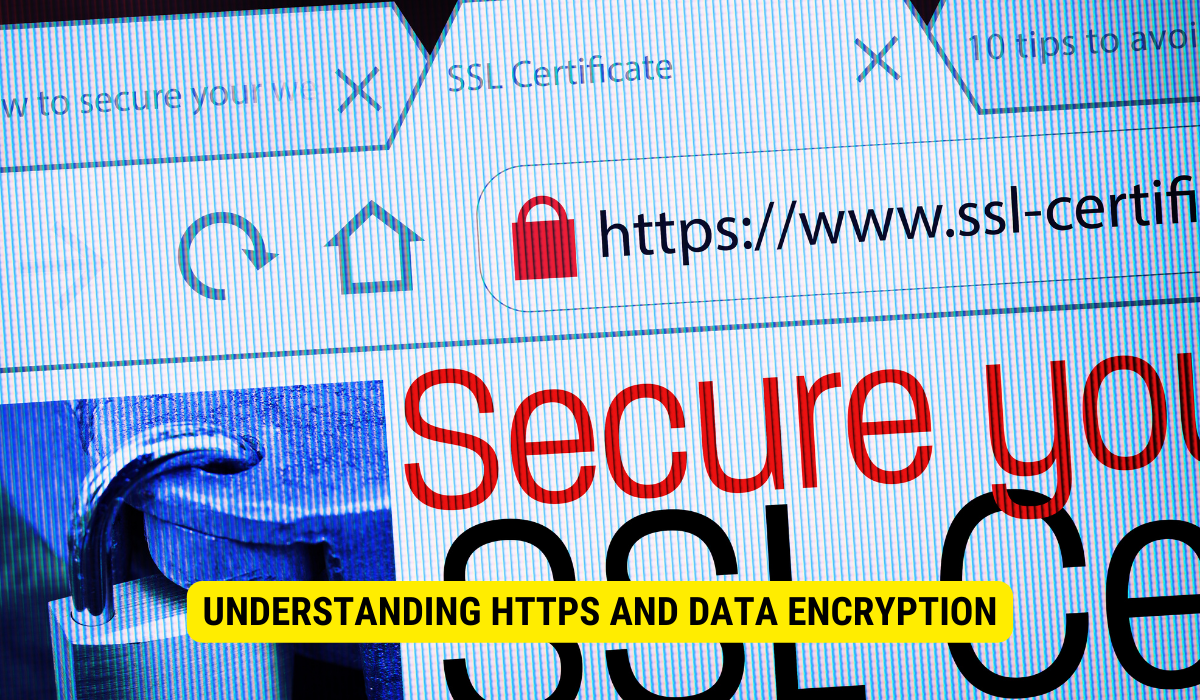HTTPS still encrypts data without a valid certificate, but it lacks the authentication and trustworthiness associated with certificates issued by trusted authorities.
In today’s digital age, information safety is paramount. As users browse the internet, they often encounter the familiar “https” in website URLs, indicating that the connection between their device and the website is encrypted. But what happens when a website operates without a valid certificate? Does HTTPS without a certificate still encrypt data? Let’s dive deeper into this topic to recognize the role of HTTPS and data encryption.
Understanding HTTPS and Data Encryption
Before we address whether HTTPS without a certificate encrypts data, let’s first grasp the concept of HTTPS and its significance in securing our online interactions. Hypertext Transfer Protocol Secure is a communication protocol that safeguards data during transmission over the internet. By adding an extra layer of safekeeping through encryption, HTTPS helps protect sensitive information from prying eyes.
When we browse the internet, we often take the security measures that protect our data for granted. However, understanding how HTTPS works and its role in data security can give us a greater appreciation for the technology that keeps our information safe.
The Role of HTTPS in Data Security
HTTPS plays a crucial role in data security by ensuring the confidentiality and integrity of the information exchanged between a user’s device and a website. When you access a website through HTTPS, your browser and the website’s server establish a secure connection using SSL/TLS protocols. This connection encrypts the data transmitted, making it unreadable to anyone attempting to intercept it. Thus, HTTPS mitigates the risk of eavesdropping and data tampering.
Imagine you are entering your credit card information on an online shopping website. Without HTTPS, this sensitive data would be transmitted in plain text, making it defenseless to interception by malicious actors. However, with HTTPS, the data is encrypted before transmission, ensuring that even if someone manages to intercept it, they won’t be able to decipher the information.
Furthermore, HTTPS also verifies the authenticity of websites through digital certificates. Trusted certificate authorities issue these certificates and prove that the website you are visiting is legitimate. This prevents attackers from impersonating websites and tricking users into sharing their personal information.
What is Data Encryption?
Data encryption is a process that converts plain, readable text into an encoded format that is indecipherable without the proper decryption key. Encryption algorithms scramble the original data into ciphertext, rendering it unreadable. In the case of HTTPS, this encryption process protects information such as login credentials, credit card details, or personal data, ensuring that only authorized recipients can understand the information.
Encryption algorithms use complex mathematical calculations to transform the data into an unreadable format without the corresponding decryption key. This ensures that even if an attacker intercepts the encrypted data, they won’t be able to make sense of it without the decryption key.
It’s important to note that data encryption is not limited to HTTPS. It is a fundamental concept in information security and is used in various applications, such as secure messaging, file storage, and virtual private networks (VPNs). By encrypting data, organizations and entities can protect their sensitive data from unlawful access and maintain the confidentiality of their communications.
In conclusion, HTTPS and data encryption work hand in hand to secure our online interactions. HTTPS ensures that the data we transmit is encrypted, making it unreadable to unauthorized individuals. Encryption is vital in protecting sensitive information, such as login credentials and credit card details, from falling into the wrong hands. Understanding the importance of HTTPS and data encryption empowers us to make informed decisions regarding our online security.
The Importance of Certificates in HTTPS
Certificates play a significant role in the functioning of HTTPS. They are digital files issued by trusted third-party certificate authorities (CAs) that authenticate the identities of websites, ensuring that you are connected to a genuine website and not an imposter seeking to intercept your data.
Defining Certificates in Web Security
Certificates act as digital passports for websites, allowing them to prove their authenticity to web browsers and establish secure connections. A certificate contains the website’s public key and other identifying information, such as the domain name. When you access a website through HTTPS, your browser checks the website’s certificate to verify its legitimacy.
Let’s dive deeper into the process of certificate verification. When you visit a site, your browser receives the certificate presented by the server. It then checks the certificate’s digital signature to ensure a trusted CA issued it. The browser also verifies that the certificate has not expired and is associated with the correct domain. This rigorous verification process helps protect users from potential phishing attacks and ensures the integrity of the HTTPS connection.
Furthermore, certificates are not limited to websites alone. They also secure email communication, digital signatures, and code signing. Certificates serve as a trust anchor in each case, providing a secure foundation for various online interactions.
How Certificates Contribute to HTTPS Encryption
Certificates play a crucial role in the encryption process. They enable the browser and the website’s server to create an encrypted connection using SSL/TLS protocols. During this process, the server shares its public key with the browser, which the browser uses to encrypt the data it sends. Only the server possessing the corresponding private key can decrypt this data, ensuring secure communication.
Let’s take a closer look at the SSL/TLS handshake process. When you initiate a connection to a website using HTTPS, your browser and the server engage in a series of steps to establish a secure channel. The server presents its certificate to browser containing its public key. The browser then generates a random symmetric encryption key and encodes it using the server’s public key. This encoded key is sent to the server, which uses its private key to decrypt it. The browser and the server now possess the same symmetric encryption key, which they will use to encrypt and decrypt the data transmitted during the session.
It’s worth noting that certificates have a limited validity period, typically ranging from one to three years. This ensures that websites regularly update their certificates, reducing the risk of compromised security. Certificate revocation mechanisms, such as Certificate Revocation Lists and Online Certificate Status Protocol (OCSP), also exist to promptly revoke certificates in case of compromise or expiration.
In conclusion, certificates are essential for establishing trust and enabling secure online communication. They are a fundamental component of HTTPS, ensuring your information remains confidential and protected from unauthorized access. By verifying the authenticity of websites and facilitating encryption, certificates play a vital role in maintaining the security and integrity of online interactions.
HTTPS Without a Certificate: What Happens?
Now, let’s address the question: what happens when a website operates without a valid certificate and still uses HTTPS?
The Process of Data Transmission Without Certificates
When a website operates without a valid certificate, the browser encounters difficulties in verifying the website’s authenticity. Instead of trusting the website’s identity, the browser warns the user, indicating a potential security risk. However, despite this warning, the data transmission in HTTPS without a certificate still undergoes encryption.
Potential Risks and Vulnerabilities
Although the data transmission without a valid certificate is still encrypted, there are risks involved. Users cannot be certain of the website’s legitimacy without a trusted certificate, making them susceptible to phishing attacks and other malicious activities. Additionally, websites may become vulnerable to more advanced attacks without proper certificate management, compromising data security.
Alternatives to Traditional HTTPS Certificates
While traditional HTTPS certificates issued by trusted CAs remain the gold standard for securing websites, some alternatives can be explored in certain scenarios.
Self-Signed Certificates and Their Role
Self-signed certificates are an alternative to traditional certificates issued by CAs. As the name suggests, the website generates and signs these certificates. While self-signed certificates still enable encryption, they lack the validation and trustworthiness of certificates issued by established CAs. Therefore, self-signed certificates are more suitable for internal networks or limited usage scenarios but not recommended for public-facing websites.
Third-Party Certificate Authorities
In addition to self-signed certificates, websites can obtain certificates from alternative certificate authorities. Though not as widely recognized as the major CAs, these authorities provide an extra layer of security and validation, ensuring that websites can establish secure connections and encrypt data.
Enhancing Web Security Beyond HTTPS
While HTTPS with a valid certificate remains the cornerstone of web security, it is essential to implement additional measures to fortify data protection.
Additional Measures for Data Protection
Beyond HTTPS, websites can employ various security measures to enhance data protection. This includes implementing robust firewall systems, regularly updating software, and conducting vulnerability assessments. Employing secure coding practices and educating users about potential cybersecurity threats can also go a long way in safeguarding sensitive information.
The Future of Web Security and Encryption
As technology evolves, so do the methods used to ensure web security and data encryption. Innovations such as quantum-resistant encryption algorithms and zero-trust architectures are emerging to counter the ever-evolving cyber threats. By staying updated on the latest developments in web security, organizations and individuals can better protect their data in an increasingly interconnected world.
Key Takeaways
- HTTPS encrypts data during transmission over the internet, ensuring the confidentiality and integrity of the information.
- Certificates play a vital role in the functioning of HTTPS, establishing the authenticity of websites and enabling secure connections.
- HTTPS without a valid certificate still encrypts data but poses risks due to potential security vulnerabilities and lack of authentication.
- Depending on the specific requirements, alternative options like self-signed certificates and third-party certificate authorities can be considered.
- Implementing additional security measures beyond HTTPS to enhance data protection is essential.
FAQs
Q: Can HTTPS without a certificate be trusted?
A: While the data transmitted over HTTPS without a certificate is still encrypted, the lack of authentication poses risks. It is advisable to exercise caution when accessing websites operating without a valid certificate.
Q: Are self-signed certificates secure?
A: Self-signed certificates can provide encryption but lack the validation and trustworthiness of certificates issued by established authorities. They are more suitable for limited usage scenarios or internal networks and are not recommended for public-facing websites.
Q: How can websites enhance data protection beyond HTTPS?
A: Websites can employ additional security measures such as robust firewall systems, regular software updates, vulnerability assessments, secure coding practices, and user education to protect data.
Conclusion
While HTTPS without a valid certificate still encrypts data, ensuring the authenticity of the websites we access is crucial to mitigate potential risks. By understanding the role of certificates in establishing secure connections and employing additional security measures, we can navigate the digital landscape with greater confidence, keeping our sensitive data safe from prying eyes.


